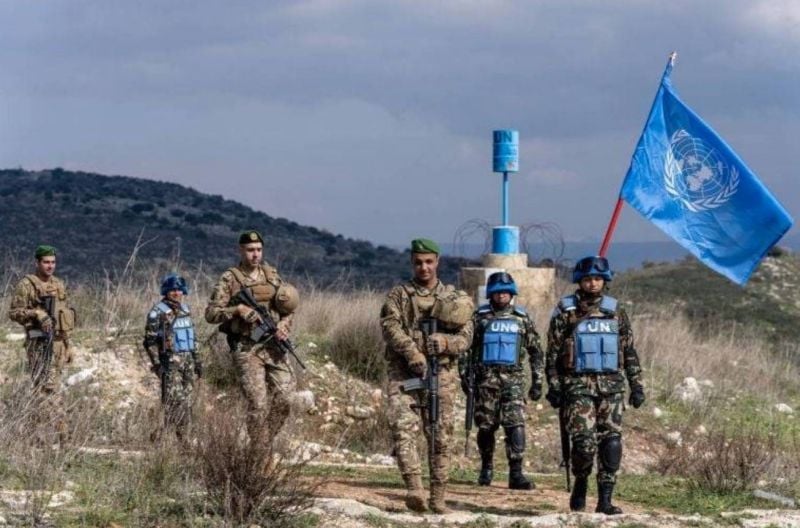
UNIFIL soldiers march alongside Lebanese Army troops near Lebanon's southern border. (Credit: UNIFIL)
Caretaker Prime Minister Najib Mikati said Thursday that Lebanon has logged “35,000 Israeli violations” of UN Security Council Resolution 1701. These violations allegedly encompass encroachments on Lebanon’s airspace, territory, and maritime sovereignty.
Though Mikati did not specify the duration or the source of this tally, the figure aligns with the “nearly 30,000” violations reported since the resolution’s adoption in August 2006. This data was initially mentioned by former General Security Chief Abbas Ibrahim on social media on Jan. 25 and was reiterated by the official National News Agency (ANI).
But who’s behind compiling and sourcing this data?
Gen. Ibrahim explained to L’Orient-Le Jour that “the Army and security agencies furnish the Foreign Ministry with figures regarding Israeli transgressions, which are then relayed to the UN.”
Additionally, caretaker Foreign Minister Abdallah Bou Habib referenced the tally of nearly 30,000 violations during his recent trip to New York on Jan. 24. At the UN, he reiterated Lebanon’s commitment to a “full” and “balanced” execution of Resolution 1701 to UN Secretary-General António Guterres.
The Foreign Ministry has not responded to requests for comment at the time of publication.
182 air violations in less than 3 months
When asked, Lebanese Army spokesperson General Elie Mezher clarified that the Army has been issuing statements on Israeli violations since 2006.
“Whenever we observe Israeli aircraft, vessel, or personnel crossing the border, we issue a statement and relay the information to the Defense Ministry,” he said.
Mezher further explained that these violations are detected “sometimes visually, but also with radar assistance.”
He added that the Army collaborates with UNIFIL, which also employs the use of radars to identify air violations.
On the Army’s website, numerous statements detail Israeli warships entering Lebanese territorial waters, Israeli soldiers crossing the Blue Line, and drones flying over Lebanese airspace.
Gen. Mezher said “Since Oct. 8, we’ve ceased publishing these statements because their frequency has surged. These are no longer mere violations but rather indicative of a state of war.”
Mezher refers to the armed conflict between Hezbollah and the Israeli army following the hostilities between Israel and Hamas in the Gaza Strip, which started on Oct. 7.
Regarding the figure of nearly 30,000 violations, Mezher clarified that “the Army hasn’t tallied all violations since 2006.”
UNIFIL deputy spokeswoman Kandice Ardiel mentioned that she does not have the complete count of violations, and directed attention to the UN Secretary-General’s regular reports on Resolution 1701’s implementation. These biannual reports outline air and ground violations of Res. 1701 witnessed by UNIFIL and perpetrated by actors on both sides of the Blue Line, which delineates the border between Lebanon and Israel.
For instance, the report covering the period between Nov. 3, 2022, and Feb. 20, 2023, revealed that “UNIFIL documented 182 air violations (by the Israeli army), totaling 206 hours and 8 minutes.”
During this same timeframe, UNIFIL also observed “381 ground violations, with Lebanese civilians crossing the Blue Line towards the south, including 268 instances involving shepherds and farmers.” Additionally, there were “320 occurrences of unauthorized weapons within its area of operations.”
However, Lebanese authorities did not provide a figure accounting for violations of the resolution committed from the Lebanese side.
Regarding Israeli violations, Ardiel clarified that “air violations are detected either visually or by radar.” However, she noted that “UNIFIL lacks the mandate to monitor maritime violations.”
Ibrahim proposed that Lebanese authorities consolidate data reported by the Lebanese Army, which monitors maritime violations alongside other transgressions, with that of UNIFIL. This would provide an estimate of around 30,000 violations encompassing maritime, land, and air domains.
Additionally, efforts to quantify these violations extend beyond Lebanese authorities.
In 2022, artist Lawrence Abu Hamdan launched the AirPressure.info platform, dedicated to tallying Israeli air violations since 2007. Hamdan curated data from 243 letters in the United Nations Digital Library spanning 2006 to 2021.
These letters, addressed to the Security Council by Lebanon’s Permanent Representative, detailed radar-detected information, including the time, duration, type, and trajectory of each air violation.
As of Dec. 27, 2022, the platform recorded 22,355 Israeli air violations. This suggests that during this period, there were no fewer than 8,000 sea and land violations by Israel.
This article was originally published in French in L'Orient-Le Jour. Translation by Sahar Ghoussoub.